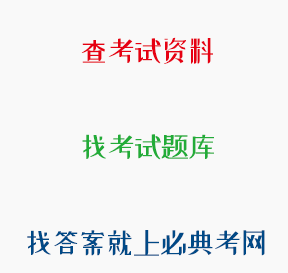正确答案: B
不符合教师资格证书定期登记制度的规定
题目:教师王某认为自己是师范毕业生而且获得了教师资格证书,就能终身从教了。王某的想法( )。
解析:《国家中长期教育改革和发展规划纲要(2010-2020年)》第五十五条规定:要完善并严格实施教师准入制度,严把教师入口关。国家制定教师资格标准,明确教师任职学历标准和品行要求并建立教师资格证书定期登记制度。题目中的教师王某认为自己获得了教师资格证就可以终身从教的想法,不符合教师资格证书登记制度,故选择B。
查看原题 查看所有试题
学习资料的答案和解析:
[单选题]中国传统医学的经典著作--《伤寒杂病论》的作者是"医圣"( )。
张仲景
解析:张仲景"医圣"张仲景的著作是《伤寒杂病论》。故选择A。B选项,孙思邈编著《干金方》,被称为"药圣"、"药王爷"。C选项,李时珍编著《本草纲目》。D选项,董奉是三国时期东吴名医。董奉隐居庐山,为人治病不取钱,但使重病愈者植杏五株,轻者一株,积年蔚然成林,因此称医学界为杏林
[多选题]当前基础教育新课程改革的最高宗旨和核心理念及具体目标。(10分)
[单选题]( )是一种有利于经济有效地、大面积地培养人才的教学组织形式。
班级授课制
解析:班级授课制是一种集体教学组织形式。班级授课制的优点:①有利于经济有效地、大面积地培养人才;②有利于发挥教师的主导作用;③有利于发挥班集体的教学作用。缺点:①主要表现在强调系统的书本知识的学习,容易产生理论与实际脱节;②强调教学过程的标准、同步、统一,难以完全适应学生的个别差异,不利于因材施教。
[单选题]所谓及时复习,应该是指( )。
在学习结束立即复习
解析:根据艾宾浩斯遗忘曲线,在学习知识20分钟以后,知识就被遗忘了42%;一天以后,遗忘就达到了66%,并且遗忘的进程有先快后慢的特点。因此,为了提高记忆效率,应及时对新学习的知识进行复习巩固,以放慢遗忘速度。及时复习是指在学习结束立即复习。
[单选题]维果斯基的最近发展区是指( )。
儿童现有发展水平与可能的发展水平之间的差异
解析:维果斯基提出了"最近发展区",他认为学生的发展有两种水平:一种是学生的现有水平:另一种是学生可能的发展水平,两者之间的差异就是最近发展区。
[单选题](2012年真题)在德育过程中,体现马克思主义"一分为二"辩证地认识学生的德育原则的是( )。
发挥积极因素与克服消极因素相结合
解析:依靠积极因素,克服消极因素的原则又称长善救失原则,德育工作中,教育者要善于依靠、发扬学生自身的积极因素,调动学生自我教育的积极性,克服消极因素。故选择A。
[单选题] The use of deferential language is symbolic of the Confucian ideal of the woman, which dominates conservative gender norms in Japan. This ideal presents a woman who withdraws quietly to the background, subordinating her life and needs to those of her family and its male head. She is a dutiful daughter, wife, and mother, master of the domestic arts. The typical refined Japanese woman excels in modesty and delicacy; she "treads softly in the world," elevating feminine beauty and grace to an art form.
Nowadays, it is commonly observed that young women are not conforming to the feminine linguistic ideal. They are using fewer of the very deferential "women's" forms, and even using the few strong forms that are known as "men's." This, of course, attracts considerable attention and has led to an outcry in the Japanese media against the defeminization of women's language. Indeed, we didn't hear about "men's language" until people began to respond to girls' appropriation of forms normally reserved for boys and men. There is considerable sentiment about the "corruption" of women's language-which of course is viewed as part of the loss of feminine ideals and morality-and this sentiment is crystallized by nationwide opinion polls that are regularly camed out by the media.
Yoshiko Matsumoto has argued that young women probably never used as many of the highly deferential forms as older women. This highly polite style is no doubt something that young women have been expected to "grow into"-after all, it is assign not simply of femininity, but of maturity and refinement, and its use could be taken to indicate a change in the nature of one's social relations as well. One might well imagine little girls using exceedingly polite forms when playing house or imitating older women-in a fashion analogous to little girls' use of a high-pitched voice to do "teacher talk" or "mother talk" in role play.
The fact that young Japanese women are using less deferential language is a sure sign of change-of social change and of linguistic change. But it is most certainly not a sign of the "masculization" of girls. In some instances, it may be a sign that girls are making the same claim to authority as boys and men, but that is very different from saying that they are trying to be "masculine." Katsue Reynolds has argued that girls nowadays are using more assertive language strategies in order to be able to compete with boys in schools arid out. Social change also brings not simply different positions for women and girls, but different relations to life stages, and adolescent girls are participating in new sub-cultural forms. Thus what may, to an older speaker, seem like "masculine" speech may seem to an adolescent like "liberated" or "hip" speech.
Today, young Japanese women have some changes in ________ from the traditional ones.
the deferential linguistic forms
解析:1.细节题。文中第一段提到了典型的日本女人受到孔子思想的影响,谦虚、优雅;只有 C选项不是日本女人的典型特征,故选C。
2.细节题。文中最后一段提到“The fact that young Japanese women are using less deferential language is a sure sign of change”即年轻女人使用的语言不再那么顺从,与B选项吻合,故选B。
3.细节题。文中第二段提到“This,of course,attracts considerable attention and has led to an outcry in the Japanese media against the defeminization of women's language”即日本媒体强烈反对女性用语中的去女性化现象。故选A。
4.细节题。文中第三段提到“…it is assign not simply of femininity, but of maturity and refinement, and its use could be taken to indicate a change in the nature of one's social relations as well.”即高度有礼貌的语言被视为一种成熟和文雅,选项C符合题意。
5.细节题。文章最后一段提到“Katsue Reynolds has argued that girls nowadays are using more assertive language strategies in order to be able to compete with boys in schools and out"选项A符合题意,故选A。
[多选题]某位高一英语教师组织了一个关于oil pollution的口语活动,学生们却对该活动没有兴趣,活动难以开展。请分析学生不感兴趣的两个主要原因(8分),并列举组织成功的口语活动应注意的三个主要事项(12分)。

 川公网安备 51012202001360号
川公网安备 51012202001360号